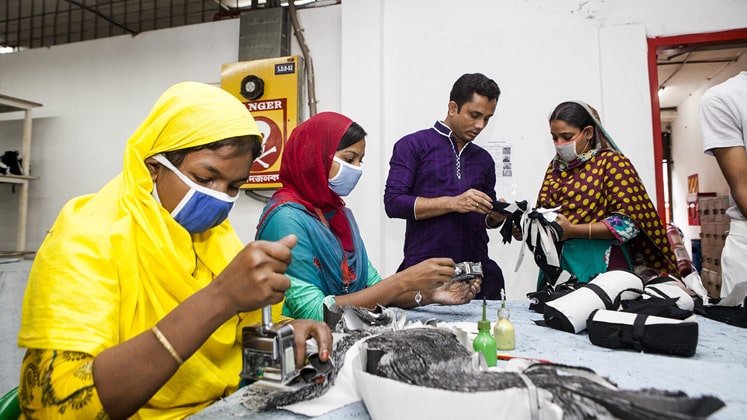
At different points of time, various numbers were thrown pertaining to the actual number of retrenched workers. However, as things started settling down, the actual number of laid off workers started to become clearer with one of the surveys putting the actual number of workers laid off at 3.57 lakh.
Although the official percentage of layoffs were shown to be 2.2 per cent out of 25.62 lakh apparel workers across the country (as per MiB database), the survey found that the actual percentage was 13.9 per cent even as first Vice-President of the Bangladesh Knitwear Manufacturers and Exporters Association (BKMEA), Mohammad Hatem, reportedly underscored that as there were not enough work orders, factory owners had to retrench workers but as per the law. However, the manufacturers reappointed or recruited workers later and the process is still continuing, he claims.
Is it in hundreds or thousands or in lakhs…? There have been a lot of speculations as to the actual number of garment workers who have lost their jobs consequent to the fallouts of the pandemic. As the COVID-19 pandemic continued to rage around the world throughout the past year, it had devastating consequences on the apparel manufacturing industry of Bangladesh.
As the retailers shut down operations in hordes subsequent to lockdowns being imposed to control the spread of the pandemic, Bangladesh apparel exporters were in for a tough time as order cancellations, factory closures, demand for discounts, payment defaults, etc., became the order of the day. And as expected, many bowed out of the business for good and those who lived to see another day had to deal with varied challenges. All these in turn adversely affected the lives of nearly four million garment workers, mostly women from rural areas, many of whom have been laid off in the wake of the pandemic.
At different points of time, various numbers were thrown pertaining to the actual number of retrenched workers. However, as things started settling down, the actual number of laid off workers started to become clearer by the day with one of the surveys putting the actual number of workers laid off at 3.57 lakh even as it reportedly alleged that most of the apparel factories did not also follow the layoff rules amid the pandemic.
Titled Vulnerability, Resilience and Recovery in the RMG Sector in view of Covid Pandemic: Findings from the Enterprise Survey, the survey conducted from October to November 2020, on 610 enterprises — the enterprises are located in the four major industrial clusters of Dhaka, Gazipur, Narayanganj and Chittagong — out of 3,211 listed enterprises, underlined that as many as 3.57 lakh garment workers lost their jobs due to the pandemic, which is much higher than the official figure of 56,372 apparel workers. The information was revealed during a virtual dialogue jointly conducted by the Centre for Policy Dialogue and Mapped in Bangladesh (MiB), which added that a good number of workers were recruited in the sector, but the actual figure could not be deduced.
About 60 per cent of the factories in the four main clusters recruited new workers amid the pandemic, the survey also said even as recruitment of workers was high in Dhaka and Gazipur, but it was also found that a section of enterprises recruited their retrenched workers at a lower wage rate and temporarily, it observed.
In his keynote presentation, Research Director at CPD, Khondaker Golam Moazzem reportedly underlined that most of the apparel factories did not follow the layoff rules amid the pandemic even as only 3.6 per cent reportedly complied with the compensation principle and paid salary, outstanding wages and other compensations while about 70 per cent of the factories only paid wages.
The survey also reportedly found that around 232 factories had shut down amid the COVID-19 crisis as of last December, which is around 6.9 per cent of the total factories in Bangladesh, among which, 188 factories were members of the Bangladesh Garment Manufacturers and Exporters Association (BGMEA).
The study also mentioned that the export-oriented sector was facing the challenges posed by the Coronavirus crisis, but thanks to the stimulus packages provided by the Government, they were now working to overcome these challenges. However, the sector’s progress of recovery is very slow and smaller factories based in Narayanganj and Chittagong, which are not members of garment associations, are facing more problems in particular.
Most of the smaller factories have failed to apply for loans from the stimulus packages due to the complexity of the procedure, said Dr. Khondaker adding that stimulus packages covered the demand of 70 per cent enterprises and those who could not manage to avail the incentive were mostly small and non-member factories.
“Ninety per cent of the large factories applied for the financial assistance, but only 40 per cent smaller factories did the same,” Dr Khondaker reportedly maintained.
Another issue raised by the survey was the so-called fall in the use of safety measures, which reportedly came down to almost half of what it was before the pandemic with as many as 13.3 per cent of the factories reported having no measures taken.
The workers’ health risk is a big challenge for the industry, reportedly underlined Chairman and Founder of CPD, Rehman Sobhan, who suggested that to overcome these challenges, a social insurance scheme with contributions from manufacturers, buyers and workers as well as donors could be looked into.
Primarily, it would be for unscheduled unemployment, Rehman added even as Coordinator of Bangladesh Garment Workers Solidarity, Taslima Akhter said, if the sector people do not concentrate on the health of workers, in future it would hit production.
“Workers will perform better when they are in good health. So, post-pandemic health-related issues should be taken into consideration seriously,” said Taslima Akhter.
With reference to the workers being laid off, the National Garment Workers’ Federation (NGWF), in a separate development has called for a maximum layoff period of 45 days. Amirul Haque Amin, President of the federation, said that previously, if there was no or less work in the factory, workers would be laid off for the first 45 days and an additional 15 days.
In total, the layoff period was a maximum of 60 days and employers then had to compensate the workers according to their reinstatement or dismissal. But the employers have been recently laying off the workers for months, providing only 40 per cent of their salaries, which is having an adverse impact on them, Amin added.
Keeping in mind the survey report and views shared by the experts, industry insiders and labour leaders, it goes without saying that Coronavirus’ impact on garment workers’ lives have been rather significant and far-reaching, which calls for stakeholders to put in joint efforts, to change things for better, not only for the workers but the industry as a whole.






